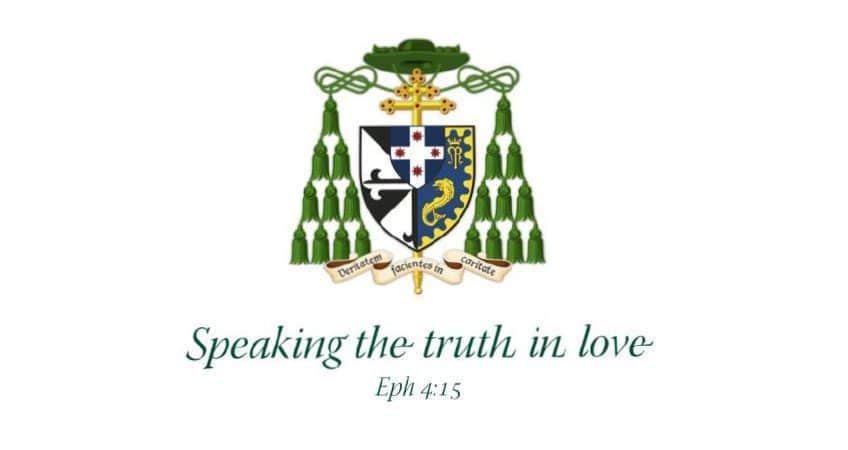HOMILY FOR THE VIGIL MASS OF ANZAC DAY EASTER THURSDAY

ST MARY’S CATHEDRAL, SYDNEY, 24 APRIL 2025
Formerly known as the Glebe Island Bridge, the longest cable-stayed bridge in Australia was completed in 1995. In a ceremony in 1998 it was renamed “the Anzac Bridge”, as a fitting memorial to those who had fought in the Australian and New Zealand Army Corps. In the year 2000 a four-metre-tall bronze of an Australian digger was dedicated at the west end of the bridge. It was sculpted by Dunedin-born sculptor Alan Somerville. Eight years later he crafted a matching bronze of a New Zealand soldier to stand opposite the Australian on the bridge. As the sun rises over Sydney, the Aussie digger’s face shines; as the sun sets, the Kiwi bids farewell to the light of day. “At the going down of the sun, and in the morning, we will remember them.”[1] Typical of Aussie-Kiwi rivalry, Somerville made the New Zealander 5cm taller than the Australian!
Our term ‘digger’ has a contested history. Some date it back to the gold rushes, others to the Aussie miners in South Africa around the time of the Boer War. More obviously, it was the nickname Australian and New Zealand soldiers got for digging trenches in Gallipoli, the Somme and elsewhere. Private Tudor Roberts wrote in 1916 that the British Tommies (not Pommies) called the Aussies diggers because they thought they were all miners or cowboys.[2] One way or another the ANZACs came to be known as diggers.
In The Spirit of the Digger, Patrick Lindsay notes that behind ‘the digger myth’ is more than a kernel of truth about ‘the digger ethos’.[3] Many here can testify to the mateship and compassion, courage and self-sacrifice, humour and resilience demonstrated by our service people in the most trying of circumstances. In addition to praying for eternal rest for the dead and peace for the living, the annual commemoration of Anzac Day allows us to celebrate the best of the Anzac spirit, while hopefully avoiding jingoism, triumphalism or romanticising war.
For despite the diggers’ hope that theirs would be “the war to end all wars”, we’ve had many since, and many ongoing, as I detailed in my introduction to this Mass—so many that the late Pope Francis designated our times “a piecemeal World War Three”. With the high cost of war in terms of human misery and scars upon the bodies and minds of individuals and whole communities, we might ask as many diggers did: where is God in all this? To which one might answer on behalf of God: where is humanity in all this? Where are the norms written in our hearts, the ideals professed in our documents, the high-sounding commitments to justice, peace and cooperation? Where are human intelligence, creativity, diplomacy, charity and religion when we most need them?
Where indeed? Anzac Day must surely be a call to recommit to our highest ideals and to protest our lowest falls. It challenges us all to give humanity cause for hope, even amidst the realities of our sinful division, and to point to God’s saving alternative, a wisdom that speaks directly to violence and peace, whether past, present and to come, whether between nations or within them, within communities and families, or within ourselves.
Because the Octave of Easter is one long celebration of Easter Day, our first reading today comes not from our usual Anzac Day selection but from the records of the first Christian preaching after Christ’s resurrection. The back story to today’s reading is that one afternoon a man who had been crippled from birth was carried to the Beautiful Gate of the Temple in Jerusalem, which was his usual begging spot (Acts 3:1-10). As Peter and John passed him by, he asked for money. [I was recently impressed that one of our city beggars had an eftpos machine so those without cash could still assist him!] Peter looked his guy in the eye and said, “Silver and gold have I none,” let alone an eftpos card, “but I’ll give you what I have: in the name of Jesus Christ the Nazarene, walk.” The man was immediately healed and started jumping about and praising God at the top of his voice. People who knew him as the city cripple “were filled with wonder and amazement” and sought out Peter and John in Solomon’s Colonnade, where today’s reading takes up the story (Acts 3:11-26).
It’s only the second Christian homily recorded; the first, also by Peter, was on Pentecost Day. Today he starts with “Why are you so surprised by this man’s healing? It was no power of mine. It was the God of Abraham, Isaac and Jacob, the God of our fathers, the God of Jesus Christ who did this thing. This Jesus was unjustly and cruelly executed, but we are here to testify that God raised him from the dead. It was faith in the name of this Jesus that made this man well. This name can be yours, also. Repent, turn to God, be conformed to that long-promised suffering Messiah, and He will restore you.”
But what would this name, this healing, this restoration mean? Our Gospel passage tonight (Lk 24:35-48) Christ’s first appearance to the Eleven after the Resurrection. And His first word to them, to calm their alarm at seeing a ghost, is “Shalom. Peace be with you.” But it’s more than a pacifier, an aspiration or even a command to be non-violent. “Shalom: peace be with you” is a new reality; the affirmation that in encountering Christ, in placing our faith in Him, in entering into His word and sacraments, we can live “the peace of Christ”, not just absence of war or of consciousness of war, not just anaesthesia against the tensions of this life, but a new wholeness, a right relationship with God, creation, our fellows, ourselves. This is “the peace of God, which surpasses all understanding”, a peace Paul says is expressed in gentleness, gratitude, intercession, contemplation, above all in rejoicing like the lame man dancing with delight (Phil 4:4-9). And with the peace of God, Paul says, comes the God of peace.
Dear friends, that the God of peace might be with us, we too seek to cultivate the gratitude, gentleness, intercession, contemplation and action such as the Apostle commends. At the going down of the sun, and in the morning, we remember with gratitude the sacrifices of those who died for the security of our country and peace in our world. We cultivate the gentleness of peacemakers to balance the strength of our honourable resolve. We intercede for the living and the dead, that the Easter Lord will transform the hearts of all those whom He blesses with “Shalom: peace be with you!”, will grant a joyful peace to the departed, and will pour His healing grace upon our world.
[1] Laurence Binyon, “For the Fallen’ The Times 21 September 1914.
[2] National World War One Museum and Memorial, “Diggers and Doughboys: The art of allies 100 years on,” https://www.theworldwar.org/exhibitions/diggers-and-doughboys-art-allies-100-years
[3] Patrick Lindsay, The Spirit of the Digger: Then & Now (HarperCollins, 2011).
INTRODUCTION TO THE VIGIL MASS OF ANZAC DAY – EASTER THURSDAY, ST MARY’S CATHEDRAL, SYDNEY, 24 APRIL 2025
Welcome dear friends to St Mary’s Cathedral in Sydney for this Vigil Mass of Anzac Day during the Octave of Easter. This evening, we recall not only those who served in Gallipoli 110 years ago tonight, but indeed all those who have served and sacrificed for our nation. Tragically, the horrors of war continue to plague our globe in what the late Pope Francis called a “piecemeal World War Three”, with conflicts persisting in Afghanistan, Pakistan and Myanmar; in Israel, Gaza, Syria and neighbours (Iran, Iraq, Lebanon, Libya, Turkey, Yemen); in the Horn of Africa (Somalia, Ethiopia), the Sudan (Sudan, South Sudan), West Africa (Burkina Faso, Cameroon, Chad, Mali, Niger, Nigeria), the Congo (Burundi, Central African Republic, Congo, Democratic Republic of Congo, Rwanda, Uganda) and Mozambique; in Colombia, Haiti and Mexico; and in Ukraine and Russia. In light of such widescale bloodshed, we pray for the peace of the Easter Lord who overcomes darkness and death with the light of His resurrection.
I acknowledge the presence tonight of: His Excellency, the Hon. Andrew Bell KC, Lieutenant-Governor of New South Wales with Ms Joanna Bird; and Lieutenant Commander Shannon Richards Aide-de-Camp;
From the Royal Australian Navy I salute: Commodore Michael Harris, Commander Michael Letts, Commander Simon Kelly, Commander Andrew Dale, Lieutenant Commander Shannon Richards, Archdeacon Darren Hindle representing Rear Admiral Chris Smith AM, Chaplains Adrian Gomez and Graham Swan, and other officers, sailors and chaplains.
From the Australian Army: Major General Matthew Burr, Major General Ana Duncan, Brigadier Marcus Fogarty, Colonel Reuben Bowd, Colonel Warwick Young, Major Brett Cooper, Major Michael Godbold, Lieutenant Kai Gres, Captain Jordan Grantham, Chaplain Sarah Gibson, and other officers, soldiers and chaplains; as well as Colonel Reuben Bowd of the Army Reserves and Major Mike Lawry of the New Zealand Army.
From the Royal Australian Air Force: Group Captain Herman Wong, Wing Commander Frank Di Stefano, Wing Commander Chris Gibson, Chaplain John Knight, and other officers, pilots and chaplains; as well as Squadron Leader Col Gilbertson of the Airforce Reserves.
I acknowledge all other past or present members of our Defence Forces, Reserves, and Cadet Brigades, with their family members. I greet Mr Paul James, Director of Returned and Services League NSW representing President Mick Bainbridge; Julie Bowden from Legacy; and all other members of Veterans organisations.
From the Consular corps I recognise: the Consuls-General or representatives of Malta, Jamaica, New Zealand, Timor-Leste, Türkiye and the United States of America. Also, representatives from NSW Ambulance, Police, the Judiciary and the Academy.
I welcome His Grace Bishop Daniel of the Coptic Orthodox, Fr Fadi Nemme of Antiochian Orthodox, and representatives of our other sister churches. Concelebrating with me tonight are their Excellencies Archbishop Amel Nona of the Chaldean Catholic Eparchy and Bishop Robert Rabbat of the Melkite Greek Catholic Eparchy; their Lordships Bishops Richard Umbers and Terry Brady of Sydney, and several present or former service chaplains. Also present are representatives of several religious congregations, church agencies and affiliates.
Every year on the Vigil of ANZAC Day we gather to remember and pray for eternal life for those who have fallen in war, especially our own; to intercede for those who grieve them and for those still suffering from injury or loss in their time in the armed services; to pray that the rest of us will never be tested as they were and that there will be peace in our times; and to recommit ourselves to their worthy ideals.

